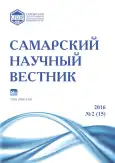Informal religiosity of central Volga area and Ural area «Muslim» peoples in 1960–1970
- Authors: Idiatullov A.K.1, Galimova L.N.2
-
Affiliations:
- Ulyanovsk State Pedagogical University
- Ulyanovsk Institute of Civil Aviation named after Chief Marshal of Aviation B.P. Bugaev
- Issue: Vol 5, No 2 (2016)
- Pages: 126-130
- Section: 07.00.00 – Historical Sciences and Archaeology
- URL: https://journals.rcsi.science/2309-4370/article/view/22092
- DOI: https://doi.org/10.17816/snv20162212
- ID: 22092
Cite item
Full Text
Abstract
In recent years there has been an increased interest in Islam and Islamic law. Islam plays a very significant role in the modern world. Close interaction between legal and religious prescriptions of Islam, the religious basis of Muslim law, «Muslim» character is not in doubt. The article analyses informal religiosity of «Muslim» peoples of the Middle Volga and Urals in the 1960–1970. This time for relations between the authorities and Islamic institutions is relatively liberal. The restoration and development of «official», allowed in the Soviet Union, as well as quite nontraditional for the Soviet time Islamic practices are noted by the authorities in the Middle Volga and the Urals. The reports name such informal forms of religiosity as neo-paganism, «wandering» mullahs, unofficial Muslim groups, worship, places of burial of saints and Sufi sources. The authorities, the party authorities, the official Muslim clergy stopped all forms of unofficial religiosity. For the «Muslim» peoples Islam has often been the subject of interest as a cultural component of their traditional worldview rather than a religious system. The authors believe that the Islamic religion has moved from ethno-cultural to the personal, informal level.
Full Text
##article.viewOnOriginalSite##About the authors
Azat Korbangalievich Idiatullov
Ulyanovsk State Pedagogical University
Author for correspondence.
Email: azkoidiat@yandex.ru
candidate of historical sciences, associate professor of the Chair of Geography and Ecology
Russian Federation, UlyanovskLilia Nadipovna Galimova
Ulyanovsk Institute of Civil Aviation named after Chief Marshal of Aviation B.P. Bugaev
Email: galina_200475@mail.ru
doctor of historical sciences, professor of the Chair of Social Sciences and Humanities
Russian Federation, UlyanovskReferences
- Гусева Ю.Н. Российский мусульманин в ХХ веке (на материалах Среднего Поволжья). Самара: ООО «Офорт», 2013. 416 с.
- Гусева Ю.Н. Ишанизм как суфийская традиция Средней Волги в XX веке: формы, смыслы, значение / под ред. О.Н. Сенюткиной; под общ. ред. Д.В. Мухетдинова. М.: ИД «Медина», 2013. 214 с.
- Ибрагимов Р.Р. Государственно-конфессиональные отношения в Татарстане в 1940–1980-е гг.: дис. … канд. ист. наук. Казань, 2004. 225 с.
- Идиатуллов А.К. Духовная культура татар-мишарей Ульяновской области (в контексте проблемы религиозного синкретизма). Ульяновск: УлГТУ, 2010. 172 с.
- Ислам в СССР. М.: Мысль, 1983. 173 с.
- Ишмухаметов З.А. Социальная роль и эволюция ислама в Татарии (Исторические очерки). Казань: Татарское книжное издательство, 1979. 224 с.
- Кобзев А.В. Холодная «оттепель»: советское государство и мусульманская община в 1940-х – 1950-х гг. (по материалам Ульяновской области) // Власть. 2013. № 8. С. 141–144.
- Королёва Л.А., Королёв А.А. Ислам в СССР: некоторые аспекты государственно-религиозной политики // Альманах современной науки и образования. Тамбов: Грамота, 2008. № 6 (13). Ч. I. С. 110–112.
- Королёв А.А. Власть и ислам в СССР в послевоенный период (по материалам Пензенского региона) // Вестник Томского государственного университета. 2007. № 303. С. 86–89.
- Национальный архив Республики Башкортостан. Ф. 122. Оп. 47. Д. 249.
- Национальный архив Республики Татарстан. Ф. Р-873. Оп. 1. Д. 46.
- Одинцов М.И. Государство и Церковь в России. ХХ в. М.: Луч, 1994. 171 с.
- Стамболиди А.В. Государственно-конфессиональные отношения в СССР в середине 60-х – начале 80-х годов XX века: дис. … канд. ист. наук. Москва, 2009. 157 с.
- Старостин А.Н. Мусульманское сообщество Среднего Урала в конце XIX – начале XXI вв.: дис. …канд. ист. наук. Екатеринбург, 2010. 370 с.
- Тюрина Л.В. Государство и Русская Православная Церковь: эволюция отношений. 1917–2000: автореф. дис. …канд. ист. наук. Курск, 2000. 23 с.
- Яблоков И.Н. Кризис религии в социалистическом обществе. М.: Знание, 1974. 64 с.
Supplementary files






